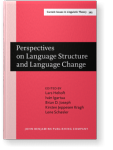Grammaticalization and degrammati(calizati)on in the development of the Iranian verb system
The present article contributes to the current theoretical discussions regarding the issues of grammaticalization, degrammati(calizati)on and reanalysis as practiced by scholars working predominantly in West European, Greek and Slavic languages. It brings into discussion relatively under-represented data from the West Iranian languages by surveying fundamental morphological and syntactic changes observable in the development of the verb systems of Persian, Tajik, Kurdish and Balochi: (i) the realignment of the Old Persian possessive construction as the finite verb form in Middle Persian, (ii) the establishment of the analytic Perfect in Early New Persian, (iii) degrammati(calizati)on of the copula in the Perfect aspect in Kurdish and Balochi, (iv) grammaticalization of the adverb hamēw ‘always’ as the Imperfect marker in Early New Persian, (v) the formation of the modal future tense in New Persian, and (vi) the role of grammaticalization and degrammati(calizati)on in the renewal of the passive diathesis in Early New Persian.
Article outline
- 1.Introduction
- 2.The realignment of the erstwhile possessive construction as the finite verb form
- 3.The establishment of the analytic perfect in early new Persian
- 4.Degrammati(calizati)on of the copula in retrospective (perfect) aspect
- 5.Grammaticalization in New Persian of the adverb hamēw ‘always’
- 6.Future tense
- 7.Passive diathesis
- 8.Conclusion
-
Text (Middle Persian)
-
References
References (21)
Text (Middle Persian)
Bahrām, Kārnāme Farvahši. 1378 Kārnāme Ardašīr Bābagān. Tehran: Entešārāt-e dānešgāh-e.
References
Andersen, Henning. 2009. On the origin of the Slavic aspects. In Vit Bubenik, John Hewson & Sarah Rose (eds.). Grammatical change in in Indo-European languages 123–140. Amsterdam: John Benjamins. 

Andersen, Henning. 2010. From Morphologization to Demorphologization. In Silvia Luraghi & Vit Bubenik (eds.). The Continuum Companion to Historical Linguistics, 117–146. London: Continuum.
Bănescu, Nicolae. 1915. Die Entwicklung des griechischen Futurums von der frühbyzantinischen Zeit bis zur Gegenwart. Bucharest: F. Göbl Söhne.
Bubenik, Vit. 1994. On Wackernagel’s Law in the History of Persian. Indogermanische Forschungen 99. 105–122.
Bubenik, Vit & Leila Ziamajidi. 2017. The rise of the analytic perfect aspect in West Iranian languages. Paper presented at ICHL23, San Antonio, 2017).
Cantarino, Vicente. 1974. Syntax of Modern Arabic Prose. Vol. 1. Bloomington: Indiana University Press.
Estaji Azam & Vit Bubenik. 2007. The Development of the Tense/Aspect System in Early and New Persian. Diachronica 24. 31–55.
Harris, Alice C. & Lyle Campbell. 1995. Historical Syntax in Cross-Linguistic Perspective. Cambridge: Cambridge University Press. 

Heine, Bernd. 2003. Grammaticalization. In B. D. Joseph & R. D. Janda (eds.). The Handbook of Historical Linguistics, 575–601. Oxford: Blackwell. 

Hopper, Paul J. & Elizabeth C. Traugott, 2003. Grammaticalization. 2nd ed. Cambridge: Cambridge University Press. 

Jahani, Carina & Agnes Korn. 2009. Balochi. In G. L. Windfuhr (ed.). The Iranian Languages, 634–692. London: Routledge.
Joseph, Brian D. 2003. Morphologization. In B. D. Joseph & R. D. Janda (eds.), The Handbook of Historical Linguistics. 472–492. Oxford: Blackwell. 

Joshida, Yutaka. 2009. Sogdian. In: G. L. Windfuhr (ed.) The Iranian Languages. 279–335. London: Routledge.
Kuryłowicz, Jerzy. 1965. The evolution of grammatical categories. Esquisses Linguistiques II, 38–54. München: Fink.
Paul, Ludwig. 2013. A Grammar of Early Judaeo-Persian. Wiesbaden: Reichert.
Šebková, Hana & Edita Žlnayová. 2001. Romaňi čhib. Učebnice slovenské romštiny. Praha: Fortuna.
Windfuhr, Gernot L. (ed.). 2009. The Iranian Languages. London: Routledge.
Windfuhr, Gernot L. & Perry, John R. 2009. Persian and Tajik. In G. L. Windfuhr (ed.). The Iranian Languages, 416–544. London: Routledge.
Cited by (2)
Cited by two other publications
Mofidi, Roohollah & Peter Petré
2022.
Aspectual marking from a typologically uncommon origin: a quantitative account of the development ofhamē(w)in Middle Persian.
Folia Linguistica 0:0

Mofidi, Roohollah & Peter Petré
2022.
Aspectual marking from a typologically uncommon origin: a quantitative account of the development of hamē(w) in Middle Persian.
Folia Linguistica 56:s43-s1
► pp. 97 ff.

This list is based on CrossRef data as of 29 july 2024. Please note that it may not be complete. Sources presented here have been supplied by the respective publishers.
Any errors therein should be reported to them.
